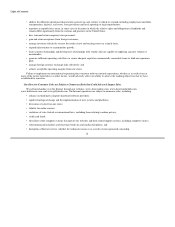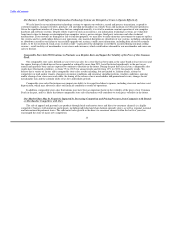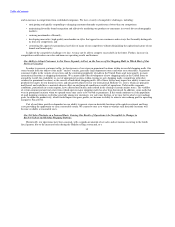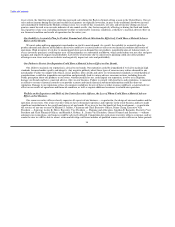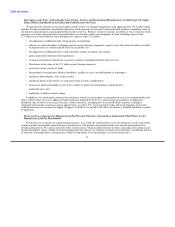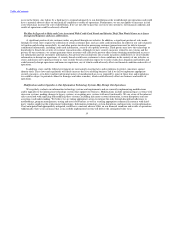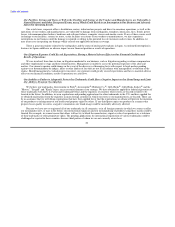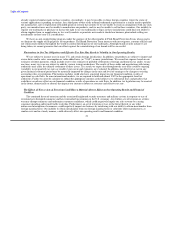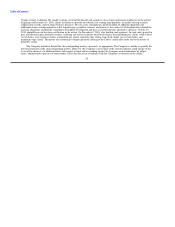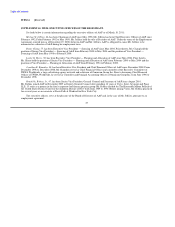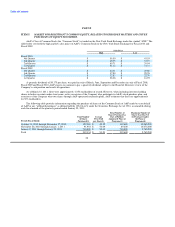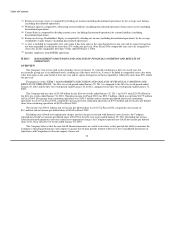Abercrombie & Fitch 2010 Annual Report Download - page 25
Download and view the complete annual report
Please find page 25 of the 2010 Abercrombie & Fitch annual report below. You can navigate through the pages in the report by either clicking on the pages listed below, or by using the keyword search tool below to find specific information within the annual report.
Table of Contents
Our Inability to Obtain Commercial Insurance at Acceptable Prices or Our Failure to Adequately Reserve For Self-Insured
Exposures Might Increase Our Expenses and Adversely Impact Our Financial Results.
We believe that commercial insurance coverage is prudent for risk management in certain areas of our business. Insurance costs
may increase substantially in the future and may be affected by natural catastrophes, fear of terrorism, financial irregularities and other
fraud at publicly-held companies, intervention by the government and a decrease in the number of insurance carriers. In addition, the
carriers with which we hold our policies may go out of business, or may be otherwise unable to fulfill their contractual obligations.
Furthermore, for certain types or levels of risk, such as risks associated with earthquakes, hurricanes or terrorist attacks, we may
determine that we cannot obtain commercial insurance at acceptable prices, if at all. Therefore, we may choose to forego or limit our
purchase of relevant commercial insurance, choosing instead to self-insure one or more types or levels of risk. We are primarily self-
insured for workers' compensation and employee health benefits. If we suffer a substantial loss that is not covered by commercial
insurance or our self-insurance reserves, the loss and attendant expenses could harm our business and operating results. In addition,
exposures exist for which no insurance may be available and for which we have not reserved.
Reduced Operating Results and Cash Flows at the Store Level May Cause us to Incur Impairment Charges.
Long-lived assets, primarily property and equipment, are reviewed at the store level at least annually for impairment, or
whenever changes in circumstances indicate that a full recovery of net asset values through future cash flows is in question. The
review could result in significant charges related to underperforming stores which could impact our results of operations. Futhermore,
our impairment review requires us to make estimates and projections regarding, but not limited to, future cash flows.
We make certain estimates and projections in connection with impairment analyses for our store locations and other property and
equipment. If these estimates or projections change or prove incorrect, we may be, and have been, required to record impairment
charges on certain store locations and other property and equipment. We have recognized significant impairment charges in the past
and may do so in the future. In Fiscal 2008 and Fiscal 2009, we recognized approximately $13.6 million and $31.4 million,
respectively, in after-tax charges associated with the impairment of RUEHL-related stores assets; and we subsequently discontinued
our RUEHL operations. In Fiscal 2010, we recorded an after-tax charge of $30.9 million associated with Gilly Hicks stores, as well as
certain other store-related assets. The Gilly Hicks charge relates to the stores constructed using the original large format store of
approximately 10,000 gross square feet, and does not affect our operating plans for Gilly Hicks. In Fiscal 2008 and Fiscal 2009, we
recognized $5.4 million and $20.4 million, respectively, in after-tax charges associated with the impairment of store-related assets
unrelated to RUEHL. As a result of these charges, our operating results have been, and in the future may be, adversely affected.
We are Subject to Customs, Advertising, Consumer Protection, Privacy, Zoning and Occupancy and Labor and Employment
Laws That Could Require us to Modify Our Current Business Practices, Incur Increased Costs or Harm Our Reputation if We
do not Comply.
We are subject to numerous laws and regulations, including customs, truth-in-advertising, consumer protection, general privacy,
health information privacy, identity theft, online privacy, unsolicited commercial communication and zoning and occupancy laws and
ordinances that regulate retailers generally and/or govern the importation, promotion and sale of merchandise and the operation of
retail stores and distribution centers. As our business becomes more international in scope and we enter more countries internationally,
the number of
22


